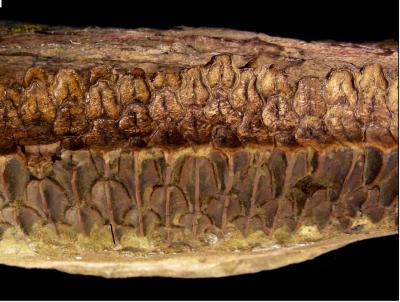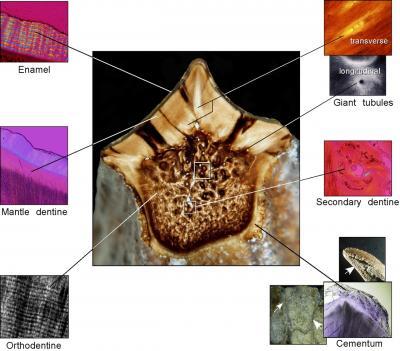Hadrosaurids were the dominant plant-eaters in what are now Europe, North America, and Asia during the Late Cretaceous, about 85 million years ago. With broad jaws bearing as many as 1,400 teeth, hadrosaurids were previously thought to have chewing surfaces similar to other reptiles, which have teeth comprised of just two tissues; enamel, a hard hyper-mineralized material, and orthodentine, a soft bone-like tissue. Paleontologists and engineers who were able to analyze the material properties of fossilized hadrosaurid teeth found that they were not that simple.
To investigate the dinosaurs' dental structure and properties in depth, they sectioned the fossilized teeth and made microscope slides from them. These revealed that hadrosaurids actually had six different types of dental tissues—four more than reptiles and two more than expert mammal grinders like horses, cows, and elephants. Using nanoindentation, in which a diamond-tipped probe is indented and/or drawn across the fossilized teeth to mimic the grinding of abrasive food, the researchers determined the differential hardness and wear rates of the dental tissues.

The horse-like chewing surface in a hadrosaurid dental battery. The crests and basins form through differential wear of the dental tissues. Credit: G. M. Erickson/Florida State University
Lead author Gregory Erickson, a biology professor at Florida State University, who describes hadrosaurid dinosaurs as "walking pulp mills," said, "We were stunned to find that the mechanical properties of the teeth were preserved after 70 million years of fossilization." He went on to comment that "if you put these teeth back into a living dinosaur they would function perfectly."
In addition to the four dental tissues found in mammals — enamel, orthodentine, secondary dentine that helps prevent cavities, and coronal cementum that supports the teeth's crests — the hadrosaurid teeth include giant tubules and a thick mantle dentine. These extra tissues are thought to provide additional prevention against abscesses. Also unlike mammalian teeth, the dental tissue distribution in hadrosaurids greatly varied in each tooth.
Together, these characteristics suggest that hadrosaurids evolved the most advanced grinding capacity known in vertebrate animals, which might have led to their extensive diversification.

Cross-section of a duck-billed dinosaur tooth (Edmontosaurus) shows the remarkably complex architecture. Six main tissues compose the tooth, where most reptiles only have two (enamel and orthodentine). Like horse, bison, and elephant teeth, the myriad of tissues--each with their own unique wear attributes--allowed the teeth to self-wear with use to form complex grinding surfaces. These dinosaurs possessed among the most sophisticated teeth known. Credit: G. M. Erickson/Florida State University
"Duck-bills' advanced tissue modification appears to have allowed them to radiate into specialized ecological niches where they ate extremely tough plants like fern, horsetail, and ground cover that were not as easy for dinosaurs with shearing teeth to eat," said Mark Norell, chair of the American Museum of Natural History's Division of Paleontology and a co-author on the new paper. "Their complex dentition could have played a major role in keeping them on the planet for nearly 35 million years."
In addition, the findings provide strong evidence that dental wear properties are preserved in fossil teeth—an idea that was once questioned and overruled in this study with comparative tests on teeth from modern and fossilized horses and bison. This opens the door for studies on the dental biomechanics of fossils from wide-ranging groups of animals to better understand evolutionary modifications in diets.
Published in Science.





Comments